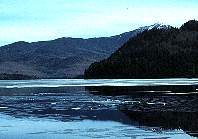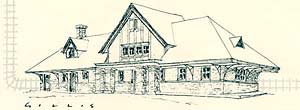| 
The history
of the Adirondacks has been shaped and influenced by many powerful forces. Logging,
mining, farming, tourism and even medicine have all played a major role in the
development of the region. In the early 1800's, towns like St. Regis, Paul Smiths
and Old Forge sprang up taking advantage of the vast timber resources and iron
ore deposits. In the central Adirondacks, pioneers cleared the large tracts of
land for farming creating the first settlements. And beginning in the late nineteenth
century, the Adirondacks became a popular destination for the rich and famous.
Known as the "Gilded Age", this period is famous for the construction of huge
rustic compounds called Great Camps. We invite you to learn more about the
history of the Adirondacks by visiting the many museums and historic sites. We
will soon have sections on logging, farming, tuberculousis, mining and so much
more. Have any history you like to submit, please
Send us an email
Historic Saranac Lake

Historic Saranac Lake, a not-for-profit organization, formed to seek National
Register of Historic Places listing for buildings in and around Saranac Lake,
New York, works to encourage historic preservation in the community through education
and research. Activities have included: the listing of 170 properties to the National
Register of Historic Places, operation of a rural preservation company, completion
of a comprehensive housing survey, two rehabilitation conferences, full rehabilitation
of two houses in the community and publication of two books and two videos on
local history and architecture. For further info please click
here.

Adirondack
Statistics |
Adirondack State Park - 6 Million Acres Adirondack Forest Preserve - 2.3
Million Acres 8,000 Sq. miles of mountains 2,000 miles of foot trails
240 lean-tos 35 campsites 200 lakes at least a square mile area There
are over 2,000 high peak mountains There are over 40 high peak mountains over
4,000 feet The highest peak is Mount Marcy at 5,344 feet There are over
50 species of animals Over 220 Birds Over 30 species of reptiles and amphibians
66 species of fish Over 2,300 lakes and ponds 1,500 miles of rivers
30,000 miles of brooks and streams |

Castles
of Ice
| The Saranac Lake Winter Carnival is a week long celebration that came
into being around the turn of the century. Developed as a traditional approach
to cure "cabin fever" for the local residents, The Winter Carnival became an annual
event in 1897. The centerpiece of the festival is the ice palace, a grand structure
built entirely of 700 pound blocks of translucent lake ice. Prior to the advent
of refrigeration, ice cutting was a thriving profession in the North Country.
Blocks of ice were harvested from the frozen lakes of the region and shipped to
the cities; packed in sawdust aboard railroad boxcars. The use of ice blocks as
building blocks was an obvious invention and the first ice palace was born. In
the initial years of Winter Carnival, the construction of the palace was the source
of much competition between the various ice cutters, the early ice palaces were
quite elaborate, with each succeeding year's buildings striving to out do the
the previous years'. Each company took pride in their design and spent many hours
sculpting the ornamentation of the palace. Present day ice palaces retain this
excitement in the choice of design, as engineering students from various colleges
die for the opportunity to see their design utilized. Construction begins in late
January as the ice blocks are harvested and assembled along the shore of Lake
Flower in the center of the Village of Saranac Lake. The design includes indoor
rooms: a throne room, staircases, towers and embattlements reaching heights of
50 feet, as well as an ice slide leading out onto the lake ice. Fabricated completely
with volunteer labor, the palace utilizes over 3000 ice blocks, each cut to size
of 2 feet wide by 2 feet thick by 4 feet long. Using slush as mortar, the blocks
are frozen in place as the palace takes form. The sheer size of the structure
is impressive and the sight of such a beautiful building created entirely of natural
materials is awe inspiring. Illuminated by interior lights, it is a marvel to
visit on a crisp winter's eve or a joy to behold on a sunny weekend day with children
scurrying along its ramparts. For Further information contact the Sarnanac
Lake Chamber fo Commerce. Main Street, Saranac Lake, N.Y. 12983. Phone: 518-891-1990. |

Adirondack
Museums
Enjoy your visit!!
The Adirondack
Museum
Blue Mountain Lake, NY - (518) 352-7311
One of
America’s finest outdoor history museums and called, “the best of its
kind in the world,” by the New York Times, the Adirondack Museum is the only
place to discover the region’s history. A magnificent new Visitors Center
and Museum Store welcome visitors to the stories of how people have lived, worked,
traveled, and played, in the Adirondacks from the early 1800s to the present.
In addition, two fine art galleries showcase some of the region’s finest
works from nationally acclaimed artists. Traditional skills demonstrations, hands-on
activities, games for the whole family, and special events are all part of the
Adirondack Museum experience.
|
Franklin County Historical Society
Malone, NY Exhibits
of early Franklin County, including victorian parlor and Dining Room, Old country
store, crafts rooms and so much more. |
Six Nation Indian Museum
Gabriels, NY Paintings, drawings, maps
and artifacts that reflect the historic and contemporary aspects of the Six Iroquois
Nations Federacy culture (Haudenosaunees). |
Constable Hall
Constableville, NY This restored nineteenth
century mansion with its original furnishings was built out of limestone. |
Historic Society of Saratoga Springs Museum
Saratoga Springs,
NY This museum use to be a gambling casino during the17th century |
Fort William Henry
Lake George, NY Restored
French and Indian War fort. Military drills, musket-cannon firing |
Awakesasne Museum
Hogansburg, NY Historical and Contemporary
Mohawk Art and Artifacts |
Chapman Historical Museum
Glens Falls, NY Delong House, Victorian
period home restored to 1865-1910 era. Exhibitions on history of southern Adirondacks |
Adirondack Park Visitor
Interpretive Center
Paul Smiths,
NY Life in the Adirondacks, its natural .history, workshops and special programs
offered. | Penfield Museum
Crown Point, NY Historic Site. Museum of local history around the 1800's.
Exhibits on the Civil War and early Iron Work | Slate
Valley Museum
Granville, NY Exhibits documenting the history of slate
quarrying. | Almanzo Wilder
Homestead
Malone, NY From The Little House On the Prairie - Laura
Ingals Husband, Almanzo Wilder Home | Webb Historical
Association
Old Forge, NY Exhibits of of the first Adirondack settlements.
| Robert Lewis Stevenson
Cottage
Saranac Lake, NY Master storyteller and author of Treasure
Island and The Strange Case of Dr. Jekyll and Mr. Hyde. |
Hancock House
Ticonderoga, NY Museum of the Adirondacks
and it also has a research library |

Calendar
of Events | Vacation Rentals |
Real Estate | Lodging
& Accomodations
Dining | Summer
Sports | Winter Sports |
Arts & Crafts | Attractions
Shopping | Adirondack
Kids | Adirondack Lifestyles |
Education
Business
Profiles | Community Links |
Business Directory | Classifieds
Adirondack History | Bulletin
Board | Chat Room | Guestbook
Comments | Return Home

BACK TO THE TOP
 43
Broadway
43
Broadway
Saranac Lake, New York 12983
Phone: 518-891-3745
Fax: 518-891-3768
E-Mail: Adirondacks.com
This
website is owned and operated by
adirondacks.com internet publishing group.
For advertising and editorial content,
please contact Rob Grant;
adirondacks.com reserves the right to reject,
modify or cancel any advertising
at its sole discretion.
© Adirondacks.com - all rights reserved |


 Shop
Shop

